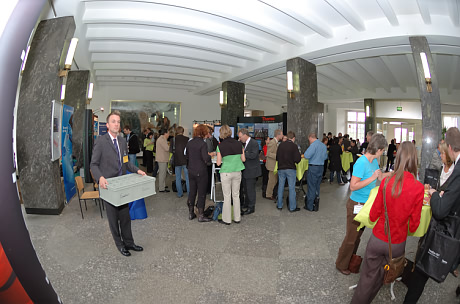continuation from
page 1....Despite the fact that the evening ended at noon, at least the official part, the attendees of the workshop joined again next day early in the morning for a session dedicated to the development of tools.

Klaus Gustav Heumann (University of Mainz, Germany) presented an invited overview on the possibilities of isotope dilution for providing accuracy in speciation analysis.
Photo 7: Klaus Heumann giving an invited lecture at TraceSoec '07The topic was continued with a contribution by Pablo Rodríguez-González (LCABIE, Pau, France) who compared different numerical approaches for multiple spiking species- specific isotope dilution analysis with respect to complexity and information provided.
Jan Kösters (Fraunhofer Institute for Molecular Biology and Applied Ecology (IME), Schmallenberg, Germany) presented a feasibility study for parallel GC coupling with both ICP-MS and EI-MS. From his presentation it became clear that it would be very attractive to have both elemental and molecular information from a single chromatographic run, however the very different sensitivities of both detection techniques are a challenge for the on-line hyphenation.
The last presentation before the coffee-break was given by Mirko Peitzsch (Institute for Geoscience, University of Mainz, Germany). He discussed the methylation of selenium by microorganisms studied by cryotrapping-cryofocussing-GC-ICP-MS (CT-CFGC-ICP-MS) analysis. The coffee-break was again used to visit the exhibition area.
 Photo 8: The TraceSpec Exhibition area [Copyright :Volker Hartmann]
Photo 8: The TraceSpec Exhibition area [Copyright :Volker Hartmann]Heiko Hayen (ISAS, Dortmund, Germany) continued the morning session with his presentation on the investigation of non-covalent metalphytosiderophore species by electrospray-high resolution mass spectrometry. He demonstrated that NANO-ESI- FTICR-MS allows for the direct analysis of small, non-covalent iron species, prevents actifact formation during chromatographic separation and is able to directly follow complex- and redox equilibria in minute sample volumes.
Ralf Kautenburger (Saarland University, Germany) followed with his contribution, discussing the role of humic acids for the mobility of lanthanides and actinides. He advocated the use of capillary electrophoresis to study complexation behaviour. This viewpoint was shared by Bernhard Kuczewski (Technical University of Graz, Austria) who also used CE-ICP-MS for the investigation of the complexation of metals within the nuclear fuel cycling.
Christian Dietz (Complutense University of Madrid, Spain) compared different approaches for sample pretreatment used for As speciation in human hair and nails.
Montserrat Filella (University of Geneva, Switzerland) ended the morning session with a contribution on trace element speciation modelling. She encouraged the auditorium to make better use of existing approaches.
The lunch break was again used to visit the exhibition area.

The Thursday afternoon session on In-situ speciation analysis and environmental speciation monitoring was initiated by Martial Taillefert (Georgia Institute of Technology, Atlanta, USA). He demonstrated that electrochemical methods play a vital role in the elucidation of the geochemical cycling of iron.
Photo 9: Martial TaillefertAs the following speaker, Günter Weber (ISAS, Dortmund, Germany) used cyclic voltammetry and FTICR/MS to follow iron uptake and metabolism in plants. Corinne Parat (LCABIE, Pau, France) advocated screen-printed sensors in stripping chronopotentiometry as a tool for in-situ measurements of trace metal speciation, and Josep Galceran (Universitat de Lleida, Spain) showed how AGNES (absence of gradients and Nernstian equilibrium stripping) is able to measure free Zn concentration in seawater.
During the following coffee break the participants were busy with visiting the poster session II during which 39 posters were on display.
 Photo 10: Poster session II
Photo 10: Poster session IIAfter the break the afternoon session was continued by Maria Pesavento (Università di Pavia, Italy) with a contribution about complexing resins as sensors for the measurement of free metal ion concentration in real samples.
A. M. Mota (Centro de Química Estrutural, Lisboa, Portugal) highlighted some problems in the determination of copper complexing parameters in natural waters by voltammetry and Latif Elçi (University of Pamukkale, Turkey) showed that in lack of sophisticated instrumentation simple coprecipitaion can be used for the speciation of inorganic arsenic in natural water samples. Kerstin Leopold (Technical University of Munich, Germany) ended the session by presenting an automated mercury speciation analyzer based on atomic fluorescence.
 Photo 11: Guided city tour
Photo 11: Guided city tourThe following social program for the evening was free to all participants. A 90 min guided walk through the city of Münster was highly appreciated by the visitors who for the biggest part had not been in Münster before. The guides presented an entertaining walk through the city visiting both historical but also other places of interest. While Münster is known as the city that should not be visited without an umbrella, the whether was extremely fine with mild temperatures and blue sky this evening. Coming back from the city tour a big tent and barbecue grill had been installed for hosting the participants for the evening.
Again the hostile environment was appreciated by many participants being involved in discussions with their colleagues until late night until the organizers had to switch off the light.
 continued on page 3
continued on page 3